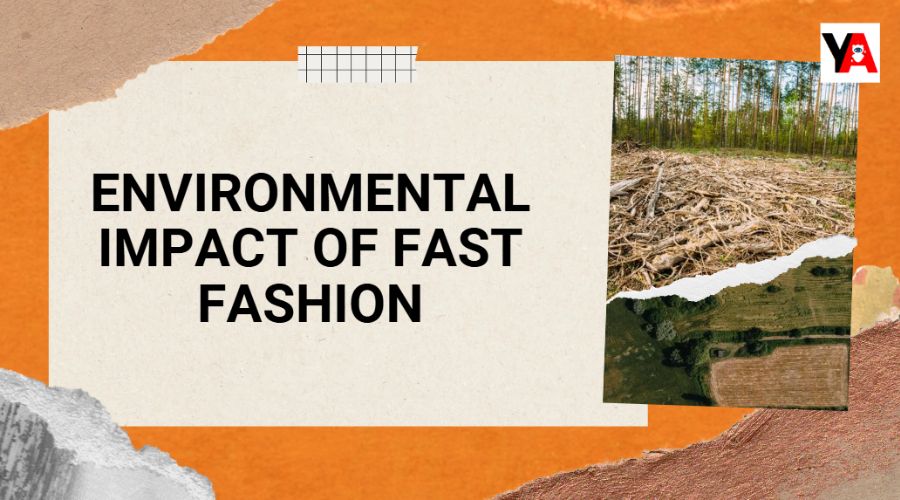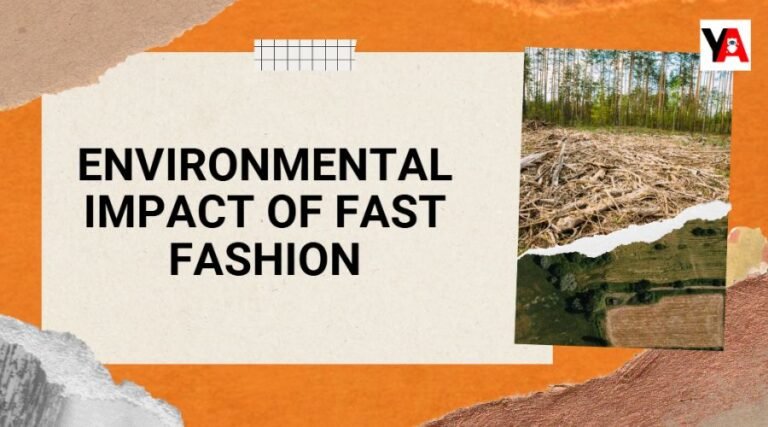Fast production of trendy clothing in high volumes at low prices, also referred to as fast fashion, is significantly causing damage to the environment.
The environmental impact of fast fashion, including waste, pollution, and depletion of natural resources, have drawn attention. The article below explores the influences in detail.
Table of Contents
ToggleThe Environmental Impact of Fast Fashion
1. Resources Depletion
The fast fashion industry requires huge amounts of natural resources including water, raw materials, energy, etc. Being a resource-intensive industry, it causes the depletion of natural resources which is among the most significant environmental impacts of fast fashion.
Usage of Water
The production of a single T-shirt made of cotton can require as high an amount of water as 2,700 liters which is almost equal to the amount that an average person may drink in 2.5 years.
Textile production consumes a huge amount of water, which is a serious problem, especially in areas where there already exists a scarcity of water.
In addition, after the production of textiles is done, there is again consumption of water when the produced items go through dying and finishing processes.
Energy Consumption
As mentioned even in the introduction part of this article, fast fashion products are known for their fast or rapid production. There is a quick TAT (Turnaround Time), which makes it essential to have highly productive manufacturing processes. These processes are energy-intensive.
For energy resources, this manufacturing industry primarily depends on fossil fuels which contributes to greenhouse gas emissions. There is a use of synthetic fibers in items related to the fast fashion category and it is derived from petroleum. As we know petroleum is a non-renewable resource.
Apart from being energy-intensive, the manufacturing processes of fast fashion items also cause the emission of greenhouse gases including Carbon Dioxide.
2. Pollution
The production processes related to the fast fashion industry release huge among of harmful wastes and chemicals. This wastage further adds to the rise in the water and air pollution.
Water Pollution
The apparel sector is responsible for about 20 percent of the industrial water pollution in the world. The use of chemicals like bleaches, dyes, finishing agents, etc is quite common in the textile production industry. These chemicals cause water pollution by ending up in local waterways.
There are also certain nations with loose environmental laws. In these countries, waste water from factories is discharged into lakes and rivers frequently. This untreated wastewater thus contaminates drinking water supplies. It also causes harm to aquatic life.
Air Pollution
Manufacturing processes being performed in factories related to the fast fashion industry cause the emission of volatile organic compounds (VOCs) and other such pollutants. These pollutants substantially add to the rise in air pollution, thus causing harm to the environment.
Moreover, synthetic fibers like polyester are used in the fast fashion industry. These fibers cause the release of microplastics into the water and air during washing. It further adds to pollution.
In addition to the above, the transportation of raw materials (used in factories) and finished products from one place to another relies on fossil fuels. As a result, it causes massive fossil fuel use, which raises air pollution and carbon emissions.
3. Waste
Fast fashion cultivates a culture of frequent changes in styles, which leads to excessive waste of material. Consumers are encouraged to discard old clothes only after a few wears and buy new items that are in trend.
Textile Waste
Textiles in huge quantities are discarded each year. Synthetic fibers take hundreds of years to decompose. Even natural fibers (treated with chemicals like dyes), on the other hand, can discharge deadly substances upon breaking down. This kind of extensive amount of waste leads to environmental degradation.
Overproduction
As the fast fashion industry is known for the production of items in large quantities to end up with the lowest costs, it causes overproduction usually. The items that are not sold are either burned or delivered to landfills.
When unsold clothing is burned, dangerous chemicals and greenhouse gasses are released. And, landfilling, on the other hand, causes contamination of water and soil.
4. Ecological Footprint
The ecological footprint of fast fashion is astonishing, which encompasses carbon footprint and biodiversity loss.
Carbon Footprint
Contribution to the carbon emission by the fashion industry, if analyzed from a global perspective, surpasses even the contribution by international flights and maritime shipping combined. The root cause of this high carbon footprint lies in the extensive consumption of fossil fuels in the industry.
Additionally, Agricultural land needed to grow fibers used in the industry adds to the need for deforestation, thus lowering the earth’s capacity to absorb carbon dioxide.
Biodiversity Loss
Cotton farming makes use of pesticides and fertilizers which kill insects and contaminate water & soil, thus harming the local ecosystems. Moreover, the construction of textile factories demands deforestation which results in threatening numerous species
Furthermore, pollution caused by textile production also causes damage to the ecosystems, thus contributing to the decrease in the populations of wildlife species.
Final Words - Environmental Impact of Fast Fashion
The environmental impact of fast fashion is, no doubt, causing harm to natural resources. But by adopting sustainable practices, both the industry and consumers can work towards preserving the planet for the future.
Frequently Asked Questions
Because fast fashion creates a lot of cheap clothing that is meant to be thrown away quickly, it is detrimental for the environment. This causes an overabundance of raw materials, energy, and water to be produced and consumed. Fast fashion production also contributes to greenhouse gas emissions, pollution, and worker exploitation in poor nations.
There are various ways that clothing waste impacts the environment. First of all, when clothing is disposed of in a landfill, toxic chemicals and greenhouse gases are released when the components decompose. In addition, there is deforestation, water pollution, and carbon emissions associated with the production and shipping of apparel. The usage of synthetic fibers in apparel contributes to the contamination of rivers and oceans with microplastics.
Slow fashion, on the other hand, promotes sustainable practices such as using natural, organic, or recycled materials, producing garments locally, and focusing on quality and longevity. This approach helps reduce the environmental impact of the fashion industry by minimizing waste, conserving resources, and supporting ethical labor practices. Slow fashion also encourages consumers to buy fewer, but higher quality, clothing items that are made to last, thereby reducing the overall demand for fast fashion products.


















